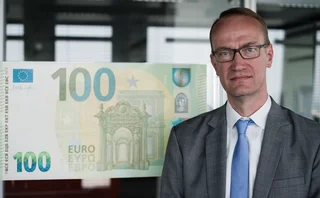
Currency initiative: The ECB and US Federal Reserve’s CDI2 standards
The pair has created an important new technical standard to support more efficient cash management

Pioneering technology is not always immediately associated with cash. But there is a tremendous amount of innovation taking place throughout the currency chain. This was highlighted in August 2020, when the US Federal Reserve chose German banknote and security firm Giesecke+Devrient to supply its ‘next-generation’ banknote-processing machines.
G+D, which has worked with the Fed for more than 40 years, won the competitive tender with a machine based on its BPS M-platform. The company says it developed a prototype to meet the Fed’s specification to process “well beyond” 100,000 banknotes an hour, with “outstanding” accuracy. It also met a critical aspect of the Fed’s specification: for the new machines needed to be CDI2-compliant.
The Federal Reserve and European Central Bank (ECB) have collaborated to redesign the Common Detector Interface (CDI) standards since early 2015. The new set of standards, named CDI2, are designed so that any given sensor can be integrated into any given banknote-processing machine.
In the past, sensors and how they attach and communicate with currency processing machines were customised to each model – each sensor effectively worked on a one-to-one basis. In the US, this kind of relationship was more tolerable, as the Fed’s cash-processing machines have only ever been made by G+D. However, each time the Fed wants to update its sensors, it is limited to a small number of sensor suppliers.
The situation is amplified in Europe, where Eurosystem central banks are free to choose different vendors across 19 different countries. Machines from G+D, CPS and Toshiba are among those currently in use. In the past, each time the ECB created a new machine-readable security feature for the euro, the sensor manufacturers had to create multiple versions of the detector to integrate into each type of machine at different central banks across the eurozone.
In January 2020, the Fed and ECB finalised the CDI2 standards, with the help of members of the Netherlands Bank, the National Bank of Austria and the Austrian Institute of Technology (AIT), as well as the US-based Lawrence Livermore National Laboratories.
“An alliance between the ECB and the Federal Reserve is something that gives some power for the discussions with sensor and machine manufacturers. So, for us, partnering with the Fed really made sense for the creation of a universal standard to be adopted by the sorting machines industry,” says Jean-Michel Grimal, head of the currency development division at the ECB.

The standards are an extension of CDI, a purely Eurosystem initiative, providing a common interface between banknote detectors and sorting machines for standardised data exchange to authenticate banknotes based on their features. In other words, the sensors would provide a ‘yes/no’ verdict on whether a banknote was legitimate or not.
CDI2 extends these specifications to allow for the integration of third-party camera systems – with optional fitness detectors – into sorting machines, providing central banks with a visual fitness assessment of a banknote.
“We think we have ticked all the boxes with this new standard, which we are certain will be fit for the next generations of high-speed banknote sorting machines,” explains Harald Deinhammer, senior team lead for banknote research and development at the ECB.
While version 2.7B is finalised, CDI2 has yet to be fully adopted: the Fed will be the first central bank to apply the standards.
“At the moment, it exists as specifications on the ECB website and as a set of simulators, but it doesn’t exist in the marketplace,” says Mark Gould, head of the Federal Reserve System’s cash product office.
The Fed received its first prototype next-generation machine from G+D in early 2020, but formal integration testing is not set to begin until late 2021.

“In the next step, an additional seven prototype machines will be provided to the [Fed] over four years for acceptance testing, to ensure requirements are met,” Gould tells Central Banking.
“Once the [Fed] has tested the different parts of the CDI2 ecosystem and machines are available on the market, the Eurosystem is considering making CDI2 compliance a requirement for future high-speed currency processing equipment procured by the Eurosystem national central banks.”
However, it is a little more challenging for the ECB to enforce the new standards.
“The main difference between the Fed and the ECB is that the Fed procures its own sorting systems. The ECB does not own a single sorting machine, but supports national central banks by defining the standards for their future equipment used to process euro banknotes,” says Deinhammer.
Increased competition
One of the inadvertent benefits of the new standards is that it will increase competition within the banknote services market. Until now, the sorting-machine market has been dominated by a few large companies, from which central banks have also been forced to buy sensors.
“It opens the door to new innovation, and will certainly enable new vendors to enter the, currently very closed, high-speed note-processing market,” says Gould. “And we may see the emergence of innovative features and technology that offer even greater banknote security features than we have now.”
Unlike with CDI, firms wishing to be CDI2-compliant will have to start from scratch.
“The collection, transfer and storage of the entire image of the banknote means there needs to be a much faster network architecture inside each machine, but also standards for transferring this data to centralised storage systems – all of this is defined in CDI2,” says Deinhammer.

“A sensor that just measures the magnetism of a banknote can typically be easily mounted onto a sorting machine, and does not require the tight note-transport tolerances of a high-resolution multi-channel camera system. For such systems, you need to specify very clearly how evenly the banknote is being transported, and you need to also have a lot more mechanical specifications and supporting acceptance criteria and tests.”
Given the impact that CDI2 would have on the industry, the central banks worked extensively with current suppliers to work out what was feasible and what was not.
“We shared different versions of the CDI2 specifications with sensor and machine manufacturers, and collected the feedback from the market, which was a very valuable experience for us,” says Deinhammer.
“When evaluating the feedback, we always kept in mind that the final standard can be implemented with reasonable effort by all existing suppliers and does not require specific licensing arrangements, but rely on open-source technologies.”
Deinhammer says there was reluctance from firms that had more market power. But in the end, the Fed’s decision to only acquire new sorting machines from firms compliant with the new standards swayed the market into co-operating, he explains.
Future benefits
In addition to increasing competition within the banknote industry, the new standards will also provide central banks with more granular data about the fitness of banknotes.
Grimal says CDI2 will build on the success of CDI1 and allow to pull in more data from the different sensors in a standardised format.
“With CDI2, there is an architecture where you get a judgement from all the sensors plus the image of the banknote in a standardised format, which you can very easily connect to a centralised database and use in a combined manner to make a final judgement on the fitness and authenticity of the processed notes,” says Grimal.
The Central Banking Awards were written by Christopher Jeffery, Daniel Hinge, Dan Hardie, Rachael King, Victor Mendez-Barreira, William Towning and Alice Shen
Only users who have a paid subscription or are part of a corporate subscription are able to print or copy content.
To access these options, along with all other subscription benefits, please contact info@centralbanking.com or view our subscription options here: http://subscriptions.centralbanking.com/subscribe
You are currently unable to print this content. Please contact info@centralbanking.com to find out more.
You are currently unable to copy this content. Please contact info@centralbanking.com to find out more.
Copyright Infopro Digital Limited. All rights reserved.
As outlined in our terms and conditions, https://www.infopro-digital.com/terms-and-conditions/subscriptions/ (point 2.4), printing is limited to a single copy.
If you would like to purchase additional rights please email info@centralbanking.com
Copyright Infopro Digital Limited. All rights reserved.
You may share this content using our article tools. As outlined in our terms and conditions, https://www.infopro-digital.com/terms-and-conditions/subscriptions/ (clause 2.4), an Authorised User may only make one copy of the materials for their own personal use. You must also comply with the restrictions in clause 2.5.
If you would like to purchase additional rights please email info@centralbanking.com




